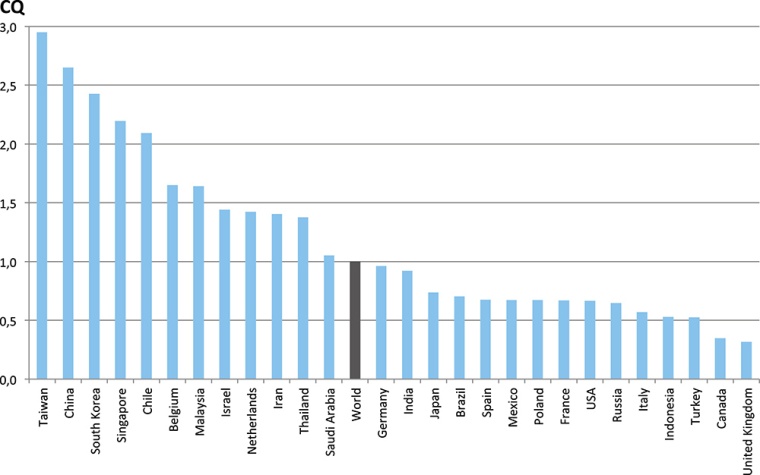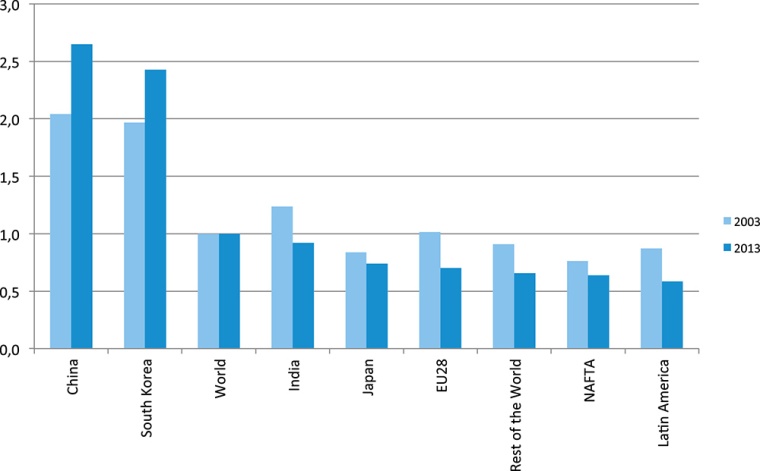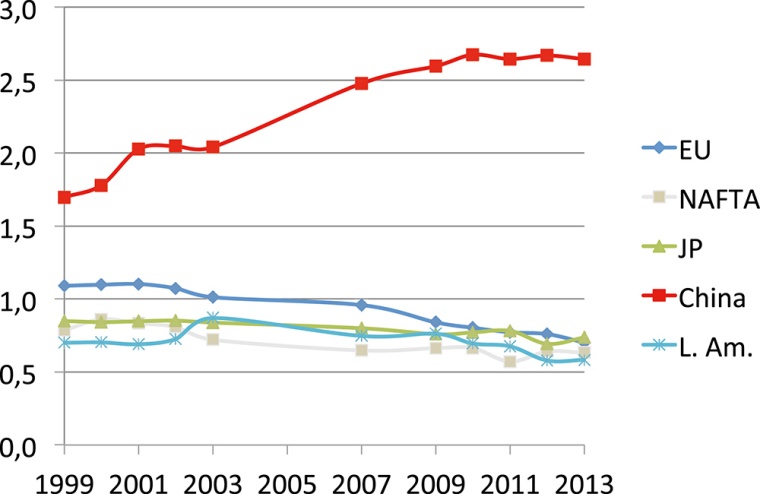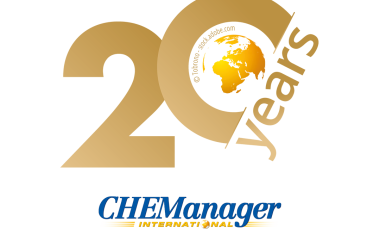Measuring China’s Importance





In the past 10 years, we have gradually become accustomed to China’s economic rise. In some ways, we are no longer as surprised by it as we should be. I realized this recently when looking at old forecasts. For example, a Deutsche Bank research report published in October 2005 gives China’s global chemical market share as 8%, and continues with a forecast (which at that time was seen as rather bullish) of this share rising to 13% in 2015, an assumption based on the domestic chemical market growing by 10% each year. As we know, in 2013 the Chinese share of the global chemical market already reached 33%, and annual growth in the period of 2004 to 2013 was not 10% but 23%.
New Measure: Chemical Quotient
Of course, during this period, not only the Chinese chemical market but also Chinese gross domestic product grew substantially. So is the increase of China’s chemical market share only a consequence of its GDP growth? To answer this question, it helps to look at the relative importance of the Chinese chemical industry compared with the rest of the world, and how it changed with time. I would like to introduce a new measure to facilitate such a comparison — the Chemical Quotient (CQ). This CQ compares the global chemical market share a country has with its share of GDP:
CQ = (global chemical market share)/(share of global nominal GDP)
Thus a CQ value above 1 means the chemical market of a country has a higher importance than its share of GDP would suggest. Similarly, a CQ value below 1 means the chemical market of a country is below its expected value based on a country’s share of global GDP.
CQ Values
So what are the CQ values for selected countries? Take a look at figure 1. It shows the CQ for those 27 countries with the biggest global chemical market share — in fact these are all countries with a global chemical market share of 0.5% or above. These 27 countries account for a total of 88% of the global chemical market.
The graph clearly shows that some countries — in particular, Taiwan, Korea and China — have a much higher contribution to the global chemical market than to global GDP. This means that these countries should be of disproportionate interest to chemical companies. Among these three, China is by far the most important because of its large absolute size. In fact, the high values of Korea and Taiwan are probably due to their close proximity to mainland China and the resulting high production of chemicals for export to China. China itself is still the global production hub, and most production processes require chemicals; the CQ reflects this.
Most of the other countries with a CQ above 1 are smaller economies, which for a variety of reasons have a disproportionately large chemical industry. Among these reasons:
- Central location, particularly with regard to shipping (Netherlands, Belgium, Singapore, with their ports and the petrochemical industry there)
- Access to raw materials (crude oil for Saudi Arabia and Iran, minerals for Chile, oleochemicals and oil for Malaysia)
In contrast, larger highly developed countries such as the US, Japan, France and the UK have CQ values substantially below 1, reflecting the fact that the service sector — while adding a large share to the GDP of these countries — requires few chemicals. Generally speaking, large segments of the chemical industry are quite mature and commoditized and thus rather cost-focused, leading to a preference for locations with low labor and investment costs and cheap raw materials rather than one with a highly educated workforce. Germany with its strong manufacturing sector and a CQ of almost 1 is somewhat of an exception. In contrast, the low CQ value of the UK is particularly striking. The country accounts for only about one-third of the global chemical market share to be expected based on its share of global GDP alone.
Rise Of China
How has the CQ developed in the past 10 years? Figure 2 gives some indications.
Clearly the rise of China as a global industrial power was accompanied by an even stronger rise of its chemical industry, as witnessed by the substantial increase of the CQ during this period. Almost all other bigger countries and regions — with the exception of South Korea with its close links to the Chinese economy — saw a corresponding decline in the CQ as they had to cede market share to the stronger Chinese competitors.
How will China’s CQ develop in the future? An analysis of the past 15 years — though complicated by the lack of some data for global chemical market share during this period — indicates that it has likely reached its peak (Figure 3).
In other words, China’s global chemical market share no longer grows substantially faster than its GDP, which will in the long run lead to a lower CQ. However, given the very high current CQ, it will take a very long time before China’s CQ gets anywhere near the global average (which by definition is 1). Assuming zero growth for China’s global chemical market share (which currently does not seem a realistic assumption as this market share has constantly increased in the past), China would have to approximately triple its GDP just to get to a world average CQ.
What does this mean for investment? China will remain a very important location for chemical industry investment. The reason is not only that China accounts for a larger and larger share of global GDP, but also that in a global comparison, China’s chemical market share is proportionately higher than justified by its GDP size alone. So while there are many difficulties in profitably investing in China’s chemical market, it is also almost impossible for global players not to do so.
Company
Managm. Consult. ChemicalsRM1302, 13/F CRE Bldg.
Wanchai, Hong Kong
China
most read

20 Years of CHEManager International
Incredible but true: CHEManager International is celebrating its 20th anniversary!

Pharma 4.0—the Key Enabler for Successful Digital Transformation in Pharma
Part 3: Seven Theses for successful Digitalization in Pharma

Lead or Lag: Europe’s AI Materials Race
How AI and Robotics are reshaping the race for materials discovery.

ECA Foundation Aims to Become Largest Pharma Association for GMP/GDP Compliance
The ECA Foundation, one of the most important not-for-profit organizations for regulatory expertise in the pharmaceutical industry, aims to become the largest independent GMP/GDP organization in the world.

ISPE Good Practice Guide: Validation 4.0
The Validation 4.0 Guide provides a comprehensive approach to ensuring product quality and patient safety throughout a pharmaceutical product's lifecycle.










